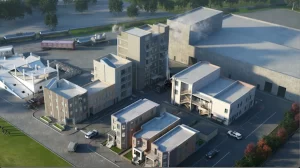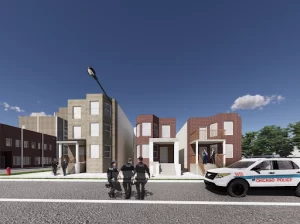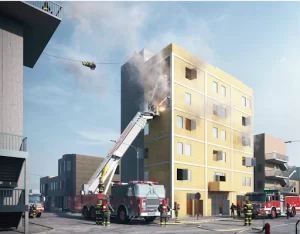Excerpts from bookclubchicago.org:
Police and firefighters will conduct training exercises in a mock neighborhood at the Joint Public Safety Training Campus on the West Side, raising the total cost of the project to $128 million.
Construction on the $33 million, state-of-the-art tactical scenario village used for police and fire training will include a fake city block, a six-story burn tower, a car crash rescue area, and other settings and props to simulate real-life emergencies. Construction is scheduled to begin this summer.
Construction on Phase 1 of the training campus at 4301 W. Chicago Ave. is nearly complete, and includes a building with classrooms, administrative offices, and an auditorium.
Renderings for the tactical village show a typical neighborhood block in Chicago, including multiple two- and three-flat residential brick buildings complete with fences, curbs, sidewalks and yards. Each building will have back stairways, porches and a two-car garage. One will have a basement. An alley with mock dumpsters will separate those buildings from a multi-story structure with shops and businesses on the ground floor plus apartments above.
Rendering of a prop city block at the Joint Public Safety Training Campus in Chicago
The $33 million price tag for the mini city scenario village is in addition to the $95 million cost of the rest of the Joint Public Safety Training Campus, bringing the total cost of the project $128 million. The Public Building Commission increased the budget for this portion of the project from $20 to $33 million in September 2021 without community input or opposition.
Despite facing strong opposition from activists and organizations like No Cop Academy when it was announced five years ago, City Council approved plans for the new West Side cop and fire academy in 2019. Instead of pouring more money into the police budget, activists wanted city hall to spend the money on housing, social services, and schools to address root causes of violence. Those organizers are now drawing parallels between Chicago’s scenario village and a $90 million safety training center set to begin construction in Atlanta, which is facing fierce public opposition.
Officials have defended the academy, saying it will play an important role in training officers and recruits so they’re better able to respond to emergencies.
The campus will allow the police department to strengthen collaboration with fellow public safety partners and continue enhancing training for officers. “This facility will also provide [the Police Department] with the tools and resources needed for modern, 21st-century policing based on national best practices.”
Rendering of a prop city block at the Joint Public Safety Training Campus in Chicago
Police and fire personnel currently train at seven different locations throughout Chicago’s city limits, including a vacant Chicago public high school in South Shore that the city leases for $1 a year from the board of education. The police also train in a residential building called a “Safe Entry training home” across the street from the main police academy at 1300 W. Jackson Blvd. Each of the seven training locations are slated to close once the new campus opens.
Construction on the mock tactical buildings is scheduled to be completed by the end of 2022. The residential-style buildings will not have water or gas service, and the interiors will be stage sets.
Besides the neighborhood block part of the village, there will be a six-story burn tower, a multi-story mixed-use live fire building, a haz-mat transportation area, a rail prop area, a car crash rescue area, and a driver training course.
A two-story technical rescue prop is designed to resemble a collapsed parking structure or train station. The rescue prop will have a series of angled and partially broken slabs of concrete with sacrificial panels meant to be removed and put back in place. It will have a series of vaults and pipes to create confined space training opportunities for firefighters and will serve as a training scenario for parking garage incidents, confined spaces, trench rescue, and collapsed building rescue.
Rendering of a prop multi-story building for fire training at the Joint Public Safety Training Campus in Chicago
Current and future firefighters will train in a live-fire commercial training tower meant to simulate high-rise and low-rise scenarios. Mounted to the top of the structure will be heavy-duty, bomb-proof anchors for tying off ropes for rappelling and other training exercises. There will also be a dedicated area for training on how to respond to car crashes and provide emergency medical treatment during extrications.
The live-fire buildings, driver training course and rescue prop areas are expected to be finished by early 2023.
thanks Dennis

































#1 by Chris W on August 17, 2022 - 11:05 AM
So once this is hypothetically up and running, what would happen to the Quinn Fire Academy? Would they still keep the QFA? Given its historical significance would CFD hold on to it, or would the bean counters and woke administration try to dump the property?
#2 by Mike on August 14, 2022 - 11:46 AM
Mike L. Don’t forget the administrative failure of the stringer / Ankum training facility that had to be deemed unsafe before using. The department has gone full circle back to the Quinn days.
#3 by Mike L on August 14, 2022 - 11:11 AM
How long until this project gets condemned for poor building, piping, wiring, etc? It’s a great plan and a much needed boost for more realistic and consolidated training but I’m not optimistic that this will be built or operate correctly. The article also fails to mention academy students had to travel 30 miles to Carol Stream while the burn cans at QFA were out of service. The city and CFD admin have an absolutely piss poor record when it comes to providing state of the art facilities for training.
#4 by Martin on August 14, 2022 - 9:37 AM
Reason Chicago isn’t adding to the fleet is politics. They pushed an order for ambulances and I’m sure there’s at least 15 in the fleet that are in decent shape to be reassign to a new companies while still keeping the spare pool well stocked.
#5 by Harry on August 13, 2022 - 8:42 PM
While this is a very cool idea and much needed but I thought the city is broke they can’t seem to add more ambulances or enough to fire rigs